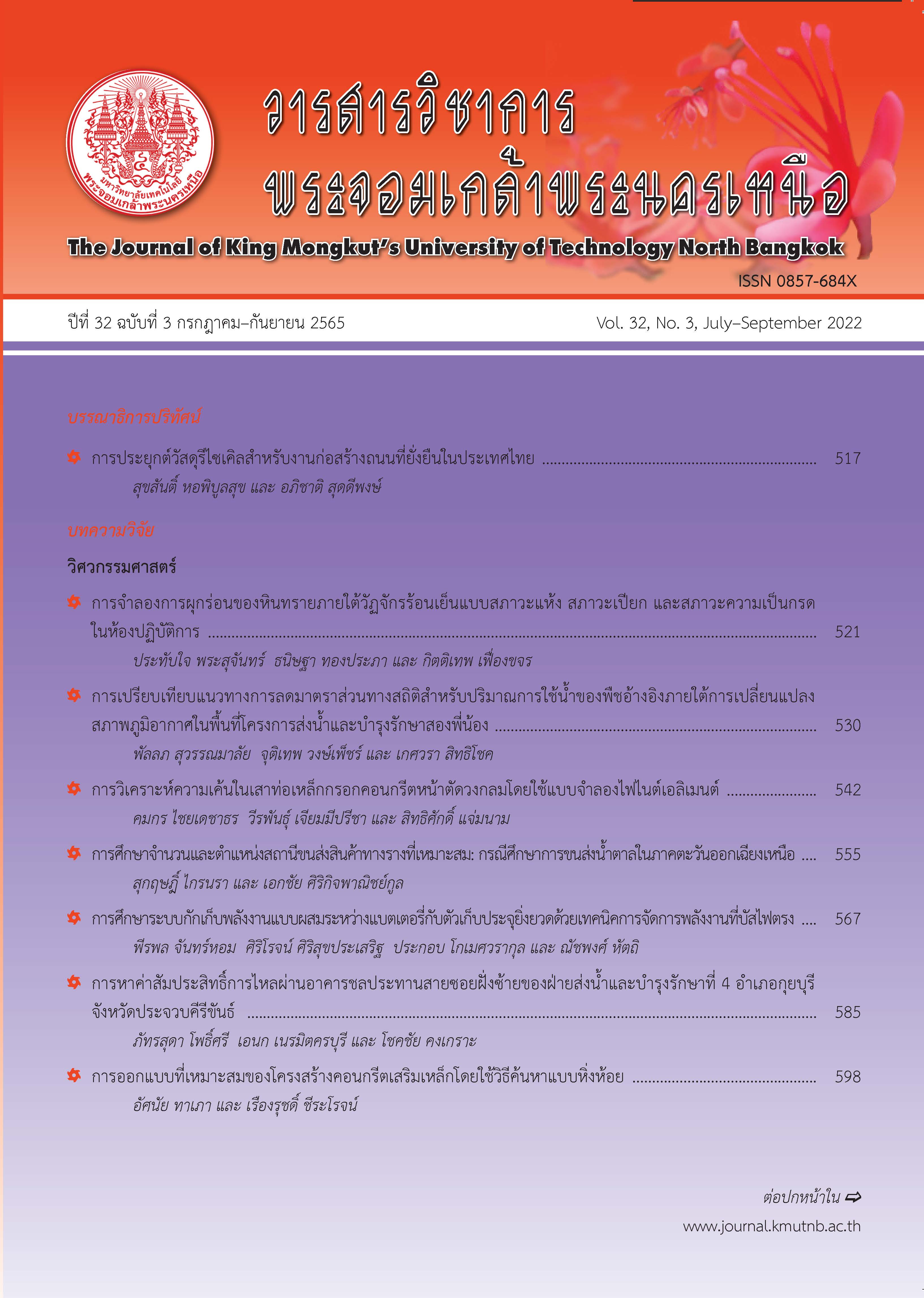การประยุกต์วัสดุรีไซเคิลสำหรับงานก่อสร้างถนนที่ยั่งยืนในประเทศไทย
Main Article Content
บทคัดย่อ
ถนน คือ ระบบโครงข่ายจราจรหลักที่ทำหน้าที่เคลื่อนย้ายคนและสินค้าไปทั่วประเทศ ถนนจึงมีส่วนสำคัญยิ่งต่อการพัฒนาคุณภาพชีวิตของประชาชนและส่งเสริมการเจริญเติบโตทางเศรษฐกิจของประเทศ การก่อสร้างถนนเพื่อขยายโครงข่ายจราจรให้ครอบคลุมทุกพื้นที่ของประเทศตามนโยบายพัฒนาโครงสร้างพื้นฐานของรัฐบาล ส่งผลให้ความต้องการมวลรวมคุณภาพดีจากธรรมชาติสำหรับใช้เป็นวัสดุก่อสร้างถนนเพิ่มมากขึ้น วัสดุดังกล่าวจึงมีปริมาณลดลงอย่างต่อเนื่องและหาได้ยากขึ้น ซึ่งส่งผลโดยตรงต่อต้นทุนการก่อสร้างถนนที่เพิ่มสูงขึ้นตามค่าใช้จ่ายในการขนส่งวัสดุจากแหล่งที่อยู่ห่างไกลที่เพิ่มขึ้น ด้วยเหตุนี้ จึงหลีกเลี่ยงไม่ได้ที่หน่วยงานทั้งภาครัฐและเอกชนที่เกี่ยวข้องกับอุตสาหกรรมก่อสร้างถนนจะต้องหาแนวทางร่วมกันในการจัดหาวัสดุทางเลือกชนิดอื่น ที่มีสมบัติเหมาะสมต่อการก่อสร้างถนนมาใช้ทดแทนวัสดุธรรมชาติที่อาจประสบปัญหาขาดแคลนในอนาคต
Article Details

อนุญาตภายใต้เงื่อนไข Creative Commons Attribution-NonCommercial-NoDerivatives 4.0 International License.
บทความที่ลงตีพิมพ์เป็นข้อคิดเห็นของผู้เขียนเท่านั้น
ผู้เขียนจะต้องเป็นผู้รับผิดชอบต่อผลทางกฎหมายใดๆ ที่อาจเกิดขึ้นจากบทความนั้น
เอกสารอ้างอิง
D. O. Olukanni, O. O. Akinyinka, A. N. Ede, and I. I. Akinwumi, “Appraisal of municipal solid waste management, its effect and resource potential in a semi-urban city: A case study,” Journal of South African Business Research, pp. 1–13, 2014.
S. Kaza, L. Yao, P. Bhada-Tata, and F. Van Woerden, What a Waste 2.0: A Global Snapshot of Solid Waste Management to 2050. World Bank Publications, 2018.
D. D. Adegoke, T. O. Ogundairo, D. O. Olukanni, and O. M. Olofinnade, “Application of recycled waste materials for highway construction: Prospect and challenges,” Journal of Physics: Conference Series, vol. 1378, no. 2, pp. 1–12, 2019.
S. Deengam, A. Suksan, and J. Suebsuk, “Unconfined compressive strength of cementstabilized soil and reclaimed asphalt pavement,” in the 4th RMUTP Conference on Engineering and Technology, 2013, pp. 21–26.
Department of Primary Industries and Mines. (2012). Volume of 100 industrial wastes from 2008–2011. Department of Primary Industries and Mines. Bangkok, Thailand. [Online] (in Thai). Available: http://recycle.dpim.go.th/wastelist/download.php.
R. Taha, A. Al-Harthy, K. Al-Shamsi, and M. Al-Zubeidi, “Cement stabilization of reclaimed asphalt pavement aggregate for road bases and subbases,” Journal of Materials in Civil Engineering, vol. 14, no. 3, pp. 239–245, 2002.
L. R. Hoyos, A.J. Puppala, and C.A. Ordonez, “Characterization of cement fiber-treated reclaimed asphalt pavement aggregates: Preliminary investigation,” Journal of Materials in Civil Engineering, vol. 23, no. 7, pp. 977–989, 2011.
A. J. Puppala, L. R. Hoyos, and A. K. Potturi, “Resilient moduli response of moderately cement-treated reclaimed asphalt pavement aggregates,” Journal of Materials in Civil Engineering, ASCE, vol. 23, no. 7, pp. 990–998, 2011.
C. S. Poon and D. Chan, “Feasible use of recycled concrete aggregates and crushed clay brick as unbound road sub-base,” Construction and Building Materials, vol. 20, no. 8, pp. 578–585, 2006.
A. M. Azam and D. A. Cameron, “Geotechnical properties of blends of recycled clay masonry and recycled concrete aggregates in unbound pavement construction,” Journal of Materials in Civil Engineering, vol. 25, no. 6, pp. 788–798, 2012.
A. Gabr and D. Cameron, “Properties of recycled concrete aggregate for unbound pavement construction,” Journal of Materials in Civil Engineering, vol. 24, no. 6, pp. 754–764, 2012.
T. Aatheesan, A. Arulrajah, M. W. Bo, B. Vuong, and J. Wilson, “Crushed brick blends with crushed rock for pavement systems,” in Proceedings of the Institution of Civil Engineers (UK), Waste and Resource Management, vol. 163, no. 1, 2010, pp. 29–35.
A. Arulrajah, J. Piratheepan, M. W. Bo, and N. Sivakugan, “Geotechnical characteristics of recycled crushed brick blends for pavement sub-base applications,” Canadian Geotechnical Journal, vol. 49, no. 7, pp. 796–811, 2012.
J. Wartman, D. Grubb, and A. Nasim, “Select engineering characteristics of crushed glass,” Journal of Materials in Civil Engineering, vol. 16, no. 6, pp. 526–539, 2004.
T. L. Landris, “Recycled glass and dredged materials,” US Army Corps of Engineers, Engineer Research and Development Center, Vicksburg, MS., Report ERDC TN-DOER-T8, 2007.
M. M. Y. Ali, A. Arulrajah, M. M. Disfani, and J. Piratheepan, “Suitability of using recycled glass-crushed rock blends for pavement subbase applications,” in Geo-Frontiers 2011 Conference on Geotechnical and Foundation Design, 2011, pp. 1325–1334.
M. M. Disfania, A. Arulrajah, M. W. Bob, and N. Sivakugan, “Environmental risks of using recycled crushed glass in road applications,” Journal of Cleaner Production, vol. 20, no. 1, pp. 170–179, 2012.
M. A. Imteaz, M. M. Y. Ali, and A. Arulrajah, “Possible environmental impacts of recycled glass used as a pavement base material,” Waste Management and Research, vol. 30, no. 9, pp. 917–921, 2012.
A. Arulrajah, M. M. Y. Ali, M. M. Disfani, and J. Piratheepan, “Geotechnical performance of recycled glass-waste rock blends in footpath bases,” ASCE Journal of Materials in Civil Engineering, vol. 25, no. 5, pp. 653–661, 2013.
V. E. Schimmoller, K. Holtz, T. T. Eighmy, C. Wiles, M. Smith, G. Malasheskie, G. J. Rohrbach, S. Schaftlein, G. Helms, R. D. Campbell, C. H. V. Deusen, B. Ford, and J. A. Almborg, Recycled Materials in European Highway Environments: Uses, Technologies, and Policies. Washington, DC, USA: DIANE Publishing, 2000.
The State of Queensland Department of Transport and Main Roads, Use of Recycled Materials in Road Construction. Brisbane, Queensland: Queensland Department of Transport and Main Roads Library Services, TN193, 2020.
Pavement Recycling, Department of Highways, Standard No. DH-S 213/2543, 2000 (in Thai).
D. A. Vermunt, S. O. Negro, P. A. Verweij, D. V. Kuppens, and M. P. Hekkert, “Exploring barriers to implementing different circular business models,” Journal of Cleaner Production, vol. 222, pp. 891–902, 2019.

